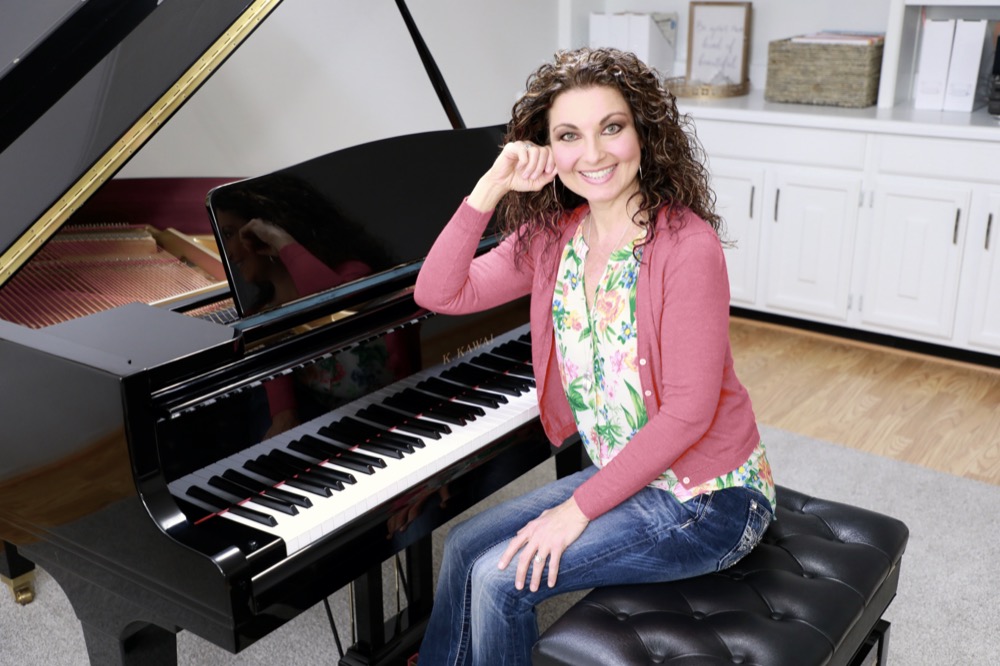The Perfect Middle C Note Reading Game for Beginning Piano Students
This post may contain affiliate links. If you purchase something through an affiliate link, I will receive a small commission at no cost to you. For more information, read the disclosure statement here.

The Middle C Note Reading Game is a fun and efficient game for beginning piano students in any primer level method book.
Ideally this game would be used once a student has learned most, if not all, the notes from F3-G4.
This game is useful for learning Middle C notes as well as reviewing them.
If there are some notes within F3-G4 that haven’t been introduced yet, a cheat sheet or whiteboard could be used to help the student with just those notes.
This game also serves as a nice breaking point after all Middle C notes have been introduced.
Students will develop confidence in their note reading skills through review and reinforcement – prior to moving onto new notes.
In this article, I’ll discuss what the Middle C Note Reading Game includes, as well as some benefits of the game and how it can be used in private piano lessons, online lessons, and group lessons.
Middle C Note Reading Game: Middle C Spelling Bee
What the Middle C Note Reading Game Includes
This 30-page PDF includes:
- List of contents including page numbers for easy reference
- The complete list of all words in the Middle C Note Reading Game
- Detailed instructions on how to print and play the game.
- Tips for using the game in online lessons.
- 2 separate game boards, depending on whether you want to add a “wild card” element for older elementary students who might enjoy a challenge.
- 6 wild “Bee” cards
- Score cards (can be laminated and written on with a dry-erase marker)
- 25 spelling cards containing three letter words.
- Blank cards – in case you or your student can come up with any additional words.

The Middle C Note Reading Game Board and Cards
The color scheme of the game board reminds me of the shades of honey, and the cards include pictures of honeybees, flowers, a matching rainbow, and a sun.
This is a game that is sure to appeal to your preschool and elementary school-aged students. They will enjoy spelling words so they can get to the beehive.
Benefits of the Middle C Note Reading Game
- Students are not just reading one note. They are learning to read notes in a grouping of three notes. This will help them to develop quicker reading skills.
- Can be easily adapted for use in online lessons and can become a go-to activity for primer level students.
- The “Bee cards” make it fun for partner lessons or small group classes.
- Students focus on directional reading and reading on the staff. Here are the combinations students will see: (T=treble B= bass) TBB, BTB, BBT, BBB, TTB, BTT, BBB, TBT, TTT
- The size of the cards are just right for younger students and for use in online lessons.
- Reading in groupings help students develop memorization skills.
Tips for Using the Middle C Note Reading Game in Private Lessons
- Can be used as an off-bench activity with the game board OR without the game board on the bench.
- If using the game without the game board, have the student read the notes first, then play them on the piano.
- If students are having trouble with directional reading, have them trace the direction of the notes with their finger before telling you the note names.
- Double check that the student knows how to use landmark notes to then find their way to other notes. I’ve found some students don’t like using Bass Clef F as their reference note.
- Figure out which landmark note(s) make sense to them, so they don’t get stuck when practicing at home.

Tips for Using the Middle C Note Reading Game in Online Lessons
- Use the Screenshare feature to show the spelling cards.
- You might use the annotation tool to draw directional lines from L-R if the student is having difficulty tracking notes.
- The game board can be incorporated via a magnetic board with magnetic game pieces. Detailed instructions and a picture of the set-up are included with your PDF.
- For more help, read 3 Easy Ways To Use Printable Games In Online Piano Lessons
Tips for Using the Middle C Note Reading Game in Group Classes
- Use the Bee Cards, especially for slightly older elementary-aged students.
- Divide the class into 2 or 3 groups, depending on the size of the class. Divide the deck of cards and see which group can finish their deck quicker. Each student should have a card they are responsible for completing.
- Use a timer to see how long it takes each group to finish their deck of cards. Then switch as many times as needed so that every group goes through all the cards.
Pairing the Middle C Note Reading Game with Other Activities and Books
This game pairs really well with the Middle C Note Reading Game Notes on the Grand Staff BOOM Cards, especially in an online lesson setting.
One benefit I’ve noticed of online lessons is that there is less (self-induced) pressure to plow through songs; it is a convenient opportunity to review concepts and notes in a fun and different way.
Once your students have mastered this game, then they will be ready for the Music Spelling Bee Treble and Bass Clef Note Reading Game.
A couple of books I like that mostly use notes of Middle C Note Reading Game are:
- PreTime Piano – Favorites by Faber – students learn to play recognizable tunes that use Middle C Note Reading Game notes only
- PreTime Piano – Jazz and Blues by Faber – all but 1 of the songs use only notes found within the Middle C Note Reading Game.
- This book is a natural next step after the Favorites book as it adds accidentals and articulations for additional reading challenges.
Grab the Middle C Note Reading Game today! It is a fun game that will help your students master their Middle C note reading skills.
Collect all the Musical Spelling Bee Note Reading Games!
- Keyboard Geography spelling bee game
- Notes in the staff musical spelling bee game
- Valentine’s Day musical spelling bee game
More blog posts to help you with fun piano teaching ideas:
Don't miss out!
Follow on Facebook and Instagram, join the best Facebook group for piano teachers, and subscribe to the newsletter to get helpful teaching tips, resources, and tutorials delivered straight to your inbox every week.
Michelle Madasamy
Michelle Madasamy
Welcome!

Hi! I’m Melody Payne, a pianist and piano teacher, educational resource author, a fun-loving wife to the most wonderful and talented hubby I could ask for, and a lifelong learner who loves to share. I want to make your life as a music teacher easier by writing and sharing helpful and relevant music teaching articles, and by creating educational resources with your very own students in mind. If you are a parent who wants to enroll your child in piano lessons, I’d love for us to get started building those skills that can give your child a lifetime of musical enjoyment!

